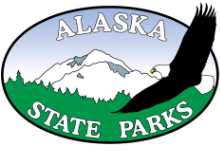Chena River State Recreation Area
Additional Information
Frequently Asked Questions
Can I bring my pet? Pets must be on leash at all campgrounds, picnic areas, parking lots and trailheads, and under complete control (e.g. voice) in the backcountry. Please clean up after your pet. 11 AAC 12.130
Can I have a fire? Fires are allowed in portable camp stoves or in a metal ring, or a small camp fire for cooking and warming is allowed on gravel bars or gravel pits. NO PALLETS. Illegal campfires have caused wildfires and scars that lasts for decades. 11 AAC 20.485
Where can I ride my ATV? The use of off-road vehicles (ATV's) is allowed in the Chena River Recreation Area only on trails officially designated and marked as open to off-road vehicles 11 AAC 20.465
Where can I ride my bike? Bicycles are allowed only in campgrounds and in the following areas: Chena Dome Hiking Trail, Mastodon Trail, picnic areas and trails designated as open to off-road vehicles. 11 AAC 20.490
Can I light off fireworks in the recreation area? Fireworks are not allowed in the park. They can injure visitors, create trash, disturb wildlife and cause wildfires. 11 AAC 12.197
Where can I snowmobile? Once the snow depth is adequate to protect underlying vegetation, snowmobiles are allowed in the park in all areas north of the Chena River, west of south fork valley and north of east fork valley. Find out if an area is open to snowmobiles by visiting our current conditions page. 11 AAC 20.480
Where can I get firewood? Wood that is both dead and lying on the ground may be gathered for use in campfires within the park. No wood can be gathered for personal use outside the park without a special use firewood permit. When in doubt, bring your own. 11 AAC 12.170
Can I pick berries in the recreation area? Berries and edible plants may be gathered for personal consumption, but not for sale. Disturbing rocks, trees, or other plants is not allowed. 11 AAC 12.170
I hear there is gold in those hills. Where can I pan for gold? Recreational gold panning is not allowed in the park without a special use permit. With a permit, you can use only non-motorized/non-electrical tools, like a pan and shovel. 11 AAC 20.045
Can I take my firearm in the recreation area? Firearms may be carried for self-protection. Target practice is only allowed at the 36.5-mile shooting range. During legal hunting seasons (limited seasons, limited areas), The discharge of any weapon (firearm, bow, air rifle, slingshot, etc.) is prohibited within ¼ mile of a developed facility (trail head, cabin, etc.). These closure zones are signed and extend ¼ mile in all directions from the facility including the shooting range. All ADFG rules and regulations apply, contact a ranger or the park office if you have more questions (907)451-2695. 11 AAC 12.190
Can I hunt or fish in the recreation area? Hunting and fishing are allowed in parts of the park during legal seasons. The required hunting and fishing licenses, and regulations published by the Alaska Department of Fish and Game, are available for purchase online and at local sporting goods stores. The viscera must not be left within 100 feet of a trail road or a developed facility. Grayling fishing catch and release. No Salmon fishing - not even catch and release.
Can I Bear Bait in the recreation area? All other park rules must be adhered to and subject to all baiting requirements specified by the Alaska Dept. of Fish and Game. Permanent structures are prohibited. Must remove everything from the bait site when hunting is completed, this includes any contaminated soils. Please be cautious and courteous to other users of the park. See Chena Rec Area Bear Baiting Information
Where can I ride my horse? Horses are allowed throughout most of the park. There are several trails that are closed to horse use and some trailheads are not suitable for horse trailers. Please visit our horseback activity page for more information. Open trails may be closed during certain seasons to prevent erosional damage. 11 AAC 20.015
When do I need a permit? Permits are required for the organized assembly of more than 20 people, any entertainment, athletic, or competitive event, any incompatible use, research involving disturbance or collection of park resources, and for commercial activities. Visit our permit page for more information. 11 AAC 18.010
Can I land my airplane or helicopter in the recreation area? Helicopter landings are not permitted in the Chena River Recreation Area. Guides are required to have a commercial use permit to land within the CRSRA. 11 AAC 20.020 No other land or water landings are allowed in the recreation area.
Where I can I use my boat in the recreation area? Boats are allowed on the Chena River. Boats on lakes are limited non-motorized or with an electric motor only. Boats must be carried by hand to the lake, a distance of up to several hundred yards. 11 AAC 20.025
Any rules on where I can drive my car? Vehicles must remain on roadways, parking areas, or camping pads. Posted speed limits and parking regulations are enforced for your safety. 11AAC12.020
Are there fees to park? Many of the trailheads have a $5-day use fee to park. These fees go to help maintaining our park facilities. If you are a frequent user, you may consider purchasing an annual pass.
What should I have with me when I go hiking? You should always carry the ten essentials when hiking in the backcountry. You never know when emergencies may happen. Extra Clothing, Extra food, Sunglasses, First Aid Kit, Knife, Matches, Fire Starter, Light source, Map, Bear Spray and Compass are essential in a hiker's backpack. Additionally, Proper footwear and Water are needed for a safe and enjoyable experience.
Are there bears in the recreation area? Bears inhabit the Chena River State Recreation Area. Please visit Alaska Department of Fish and Games Bear safety.
Are there moose in the recreation area? Moose inhabit the Chena River State Recreation Area. Please visit Alaska Department of Fish and Games Moose safety.
Is there giardia in the water? Yes, it is possible that watersheds in the park are contaminated with giardia. It is not advised to drink from any watershed prior to purification. Purify your water to avoid getting sick by boiling your water for 2 or more minutes, or you can run it through a pump filter or use chemical treatments.
Are there any poisonous plants? Yes, there are some poisonous and hazardous plants in the park. Berry picking is a popular outing in the park, and some of them are poisonous. You can bring a plant and berry identification guide to be certain before you eat any. There are also plants such as cow parsnip and devils club that can be rather unpleasant when encountered. Wear long sleeves and pants when hiking near or through them.
Can I take these antlers home that I found in the recreation area? No, antlers and any other part of an animal that is found are to remain where it lies. This is considered disturbance of natural objects, see: 11AAC 12.170.
Where can I cut a Christmas tree in the recreation area? Cutting trees in the Chena River State Recreation Area is prohibited at all times. Cutting live trees is considered disturbance of natural objects, see: 11AAC 12.170.
Will my dog get caught in a trap if I go hiking? Trapping is allowed in the CRSRA. Waring/advisory signs may be posted at trailheads but it is important that your dog remains on a leash/under control for it’s safety and the safety of others. See: AAC 20.060 for the parks regulations on pets.
Can I make reservations for a campsite? Some campsites are reservable ahead of time through ReserveAmerica.com.
Can I reserve a pavilion or Picnic Shelter? Yes, picnic shelters at Red Squirrel and Rosehip Campgrounds can be reserved by visiting https://alaskastateparks.reserveamerica.com/, search Chena River State Recreation Area, select hourly reservations, select date/time and book reservation. For more information call 907-451-2695
I have a 40' RV, do you have campsites to that will accommodate large vehicles? All three campgrounds can accommodate 40' RV's. There are no guarantees that these sites are available.
Can I use a metal detector to look for gold? No, only non-motorized/non-electrical tools may be used for recreational gold panning. This includes a gold pan and shovel only. See: 11 AAC 20.045.
Fishing in Chena River State Recreation Area
Casting for sport or for dinner, river pools and roadside ponds keep luring anglers.
On an overcast, summer day, Steve Terrill sat in a canoe on the Chena River with two of his friends. They hadn't caught a thing. The only critters biting were the mosquitoes that buzzed incessantly around their heads.
Discouraged with his lack of success, Terrill pulled on his chest waders and wandered through the braided arms of the Chena River with fly rod in hand. He waded into the shallows looking for evidence of feeding fish. In the distance he noticed a calm, deep pool lined with tall grass. He crept discreetly to the edge of the pool before attaching an elk hair caddis fly to his line. He had found the fish. With every cast he had a fighting grayling on the line. "It was a great day," Terrill said.
Arctic grayling are considered excellent sport fish because they are opportunistic feeders. During the winter they live in deep pools under the ice and don't feed much. When the ice melts, they go into a feeding frenzy on the abundant spring insects that live along the Chena River. The grayling's voracious feeding allowed anglers to pull in nearly 50,000 fish from the Chena River in the 1970s, seriously depleting the grayling population. To ensure a comeback for grayling, the Alaska Department of Fish and Game established catch-and-release regulations to protect arctic grayling in the Chena River. The regulations allow artificial, single hook lures only, no bait.
For people who enjoy angling, Chena River State Recreation Area has ponds stocked with rainbow trout and with arctic grayling. Fishing in the ponds is not limited to catch-and-release only - here comes dinner! The state recreation area has four road-accessible ponds open for fishing. These ponds are located at mileposts 30, 42.8, 45.5 and 47.9 on the Chena Hot Springs Road.
Tips for catch-and-release handling
✔Overly large hooks can damage mouth or eyes. Hooks overly small are taken in too deeply by fish. Land your catch quickly with a strong line. Avoid removing the fish from the water. Do not let it flop in shallow water, over rocks, or on dry land.
✔Remove the hook quickly and gently. When the fish is hooked deeply, cut the line near the hook rather than injure the fish. Steel hooks rust out quickly. Cradle the fish gently with both hands, one under its belly, one near its tail. Keep fingers out of and away from the gills. Never squeeze the fish.
✔Point the fish into a slow current or gently move it back and forth until its gills are working properly and it maintains its balance. When the fish tries to swim, let it go.
✔Don't give up if the fish doesn't regain consciousness. A fish under stress goes into shock similar to fainting. Continue moving water over the fish in a natural way. The process can take several minutes.
Fishing Lure Hints
For good fishing on the Chena River, try a stone fly or caddis fly. Imitation light-colored dry flies and small spinners also work well. Bait is prohibited on the river. Fishing stores in Fairbanks sell many local favorites too.
History
In 1905, just four years after Fairbanks was founded, Thomas and Robert Swan paddled a canoe up the Chena River. On their journey they encountered miraculous hot springs that cured Robert Swan's rheumatism. The Swans also found the remnants of a campfire. They learned later that the campfire had been made by Felix Pedro, the prospector who discovered gold in the local hills.
While Pedro's gold strike led to the founding of Fairbanks, the Swan's discovery of the hot springs' healing powers may have led to the founding of Chena River State Recreation Area. As soon as the Swans returned to town, Robert Swan told his story of soaking in the waters and curing his rheumatism. Soon, other ailing Fairbanks residents headed for the restorative hot springs. The waters cured their ills too, according to testimonials filed in the National Archives in Washington, D.C.
In 1913, at the request of local residents, the U.S. War Department built a trail to the hot springs. The trail was to have been an actual road, but funding ran short, and a trail - a winter only trail at that - was all the department could afford to build.
Today, people still travel the old trail in the cold and dark of winter--and without cars. Some hike, some ski, and some travel by dog sled. About ninety miles of the Yukon Quest, an annual 1,000-mile sled dog race between Fairbanks and Whitehorse, is run on the old winter trail. But traveling the trail is no longer a necessity. A paved road parallels the old winter trail and provides easier access to the hot springs.
Health-seekers were not the only Alaskans drawn to the area. In the early 1900's, the area around the springs attracted a great deal of attention. Once word got out about gold in the hills of Fairbanks, many more prospectors came to seek their fortunes. The bustling new town of Fairbanks needed wood--lots of it--and along the Chena River stood some of the largest trees in interior Alaska.
Loggers quickly learned about the forested lands between town and the hot springs. Wood from those trees became the walls and roofs of local buildings and houses. This timber fueled the fires that produced electricity. The train engines carrying miners and supplies to all the mining districts around Fairbanks relied on wood as a source of fuel as did the engines of the river steamers that carried people and supplies to Interior Alaska.
The Chena River itself was central to the use of these lands. The waterway provided summer transportation to the hot springs and served as a route by which loggers could reach the timber, and logs could be transported into town. Loggers rolled the cut trees down the hills into the river, and the river floated the logs to sawmills in Fairbanks.
Fairbanks grew in spurts. First came the gold rush, then the military. World War II and the Cold War made Alaska a strategic location for American military interests. Large numbers of servicemen came to Fairbanks prompting the growth of new stores, schools and other amenities to serve the burgeoning population. Alaska's wild lands were rapidly being tamed.
By the 1960s, shortly after Alaska became a state, people began to fear that all of Fairbanks' wild lands would be covered with concrete and condos. The concerned Fairbanks citizens took action. Groups ranging from the Fairbanks Garden Club to the Tanana Valley Sportsmen Association and the Alaska Conservation Society asked Alaska legislators to save some of the wilderness close to town. The legislators granted this request in 1967, designating 15,360 acres for the Chena River State Recreation Area.
Just one year later came the greatest challenge of all to Alaska's wilderness: the discovery of oil in Prudhoe Bay. As lands were rapidly parceled out and developed, Alaskans fought to preserve a way of life deeply interwoven with the land and its natural resources. The Alaska Legislature helped meet this challenge in 1975, designating an additional 240,000 acres for the recreation area. This action brought Chena River State Recreation Area to its present size.
At the Chena River State Recreation Area you may hike, ski, snowmachine, dog mush, horseback ride, canoe, hunt, fish, camp and experience nature as the early settlers did--all within these 254,080 acres. You can still enjoy the wilderness in this beautiful area, a goal the Alaska State Park system worked for in setting up the park.
River Guide
Floating the clear-running Chena River is a popular activity in Chena River State Recreation Area. The river flows from the Yukon-Tanana Uplands to its confluence with the Tanana River in Fairbanks. Crafts typically used are canoes, kayaks, rafts, and riverboats. Fishing, hunting, camping, wildlife viewing, sunbathing or swimming can be enjoyed along the river. Chena Hot Springs Road provides easy access to the river at several locations within the recreation area. Numerous river access roads and four bridges that cross the river allow many choices for float trips.
Class II River:
The Chena River is rated as Class II on the international scale of river difficulty. The upper portions of the river are more difficult being narrower with more obstacles, such as log jams, low hanging trees called sweepers, shallow water and sharp turns. Lower portions of the river are wider, allowing more space for maneuvering around obstacles. River gradient (water elevation drop) is typically steeper upstream.
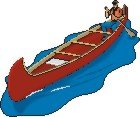 River Hazards:
River Hazards:
Because of the meandering nature of the river, the course has changed over time. The resulting riverbank erosion causes a large amount of brush--sometimes entire trees--and other debris to fall into the water, creating obstacles that make a typically "easy" river difficult to navigate. The most common mishaps on the river arise when crafts are carried into sweepers or log jams, causing the boats to capsize. Make evasive maneuvers well in advance of these hazards to minimize unplanned swims!
In many locations along the river, the river splits into two or more smaller channels. Floaters are encouraged to stop and scout these smaller channels before floating them. Many are impassable due to logjams, particularly on upper, narrow sections of the river. Periods of rain may create high water that will increase the river's flow velocity. High water also increases the river's difficulty rating. Murky water indicates higher than normal water conditions, as the river normally runs clear. Early season floaters should be aware of the potential dangers of ice jams that may form anywhere along the river.
Warning: All floaters should wear some type of U.S. Coast Guard approved personal flotation device at all times while on the river, regardless of skill level.
River Description:
4th Bridge (MP 48.9) to 3rd Bridge (MP 44.0) Gradient: 11 feet/mile
The put-in location of the 4th Bridge is also the Angel Rocks Trailhead. The North Fork of the Chena River is much narrower than the Main Fork down river. Floaters may expect many obstacles and hazards along this section. Lining or portaging your craft around logjams, shallows, sweepers, or other obstacles will likely be necessary. Mid- to late-summer floating is not recommended due to low water. Experience with technical river skills is advised.
3rd Bridge (MP 44.0) to 2nd Bridge (MP 39.5) Gradient: 8 feet/mile
A popular float starts on the narrower North Fork for a short way before joining the East Fork. Exercise caution shortly below the bridge as a log jam may require portaging. Hazardous water currents are frequently encountered at the confluence of the East Fork. Here the river widens with a brisk current and occasional riffles.
2nd Bridge (MP 39.5)
Two options are available for takeout at this bridge. A road accesses a large gravel bar just above the bridge (across the highway from the campground), offering easy water access by vehicle. The bridge is visible from this gravel bar. Floaters may also take-out at the Granite Tors Trailhead at the bridge.
1st Bridge (MP 37.8) to Rosehip (MP 27.0) Gradient: 5 feet/mile
The river remains fairly easy going with many broad sections and narrower riffles. Expect many sweepers and floating hazards. Several river access points are available. Consult the map for locations.
Rosehip (MP 27.0) to Fairbanks Gradient: 3.5 feet/mile
The gradient lessens closer to Fairbanks. Access at Grange Hall Road is not obvious. No developed facilities are present on the north of the public access. Nordale Road is the next easy access point, with vehicle access to the river just above the bridge. Several access points exist below Nordale Road into Fairbanks.
Rules and Regulations
WHILE IN THE PARK...
● Fireworks and explosives are prohibited.
● Discharge of firearms: discharge of weapons is prohibited except for lawful hunting or trapping. Target shooting is only allowed at the developed shooting range mile 36.4 Chena Hot Springs Road.
● Overnight use of a developed campsite, including designated parking areas, requires payment of a fee or an annual pass. Camping within the park is limited to 15 consecutive days thereafter.
● In developed campgrounds, camping is permitted only at a developed campsite.
● Campsites must be occupied the first night after camping equipment is set up or a vehicle is parked in the campsite.
● Campground quiet hours are from 11 p.m. to 6 a.m.
● Litter is an eyesore and a disappointment to park visitors. All refuse should be removed or placed in the litter containers provided. Refuse may not be brought into the park for disposal. In the backcountry, please pack out what you pack in and leave your campsite as you found it. Practice "no trace" camping.
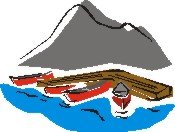 ● Fires must be confined to fire pits in the campgrounds and picnic areas, to gravel bars, or to gravel pits. Use a portable stove for heat and cooking in the backcountry.
● Fires must be confined to fire pits in the campgrounds and picnic areas, to gravel bars, or to gravel pits. Use a portable stove for heat and cooking in the backcountry.
● Wildflowers, trees, ferns, and grasses should be left for others to appreciate.
● Berry and mushroom gathering are permitted for personal consumption and household use, but not for commercial purposes.
● Dead wood lying on the ground may be gathered for a campfire where campfires are allowed.
● Cultural and archaeological artifacts must remain undisturbed.
● Motor vehicles are generally restricted to roads and parking lots. Off-road vehicles are permitted on trails designated for their use.
● Snowmachines may be used when snow depth is sufficient, except in the southeastern portion of the park.
● Operators of snowmachines and off-road vehicles must be at least 14 years old, or under the direct supervision of a parent or another person at least 21 years old.
● Bicycles are permitted on trails open to off-road vehicles. They are prohibited on the Angel Rocks and Granite Tors Trails but may be used on the Chena Dome Trail.
● Horses, mules, burros, and llamas are allowed except when on the Granite Tors Trail. Groups using ten or more animals must obtain a park use permit. Tethering animals within 100 feet of fresh water and loose herding are prohibited.
● Peddling or display of signs is prohibited.
● Pets must be on leashes at developed facilities such as campgrounds and picnic areas and may not create excessive noise. Leashes are not required in other areas, but pets should be kept under control at all times.
● Reservations are required only for the public use rental cabins and Twin Bears Camp. Permits are required for large groups of more than 20 people or for commercial activities.
Trails
Trails offer passage to adventure
Getting away from it all is easy in Chena River State Recreation Area. Well-marked and maintained trails lead into alpine country and offer strikingly different hiking experiences. Feeder trails that lead off the developed trails allow hikers to find the perfect place with unobstructed views and wilderness solitude. "The proximity of the recreation area to Fairbanks makes it feasible for day hikes and extended journeys alike," says Craig McKinnon, a Canadian who finds that the views "rival those of any other park."
Among the most popular jaunts is a hike along the Angel Rocks Trail. Hiking this trail can take a couple of hours or can become a leisurely day trip. "You can get beautiful views of the valley in a very short hike. It's great for families," explains Brooks Ludwig, Northern Area Superintendent for Alaska State Parks. The Angel Rocks Trail begins at a pleasant riverside picnic area at milepost 48.9 Chena Hot Springs Road. The 3.5 mile round trip leads hikers through dense evergreen forests up to the sheer rock faces of the Angel Rocks. The trail extends 8.3 miles to include a route along ridgelines that creates a second trailhead at Chena Hot Springs Resort, just past mile 56 on Chena Hot Springs Road.
 The Stiles Creek trail, a year-round ridge trail, provides opportunities for multiple use when it comes to choosing your mode of travel -- mountain bikes, all-terrain-vehicles, horses or hiking. The Chena Dome Trail, the longest in the recreation area, offers quick passage to hiking above timberline. It begins with lush spruce forests at low elevations and rapidly rises into stunning alpine tundra. The 29-mile trip circles the entire Angel Creek drainage area. The trail starts at mile 50.5 and ends at mile 49 Chena Hot Springs Road. The full hike takes three days, often more, but scenic day hikes can be taken from either trailhead. "If you can get above the timberline and hike across the tundra, there are many magnificent views," says Rex Blazer, a longtime northern Alaskan environmentalist.
The Stiles Creek trail, a year-round ridge trail, provides opportunities for multiple use when it comes to choosing your mode of travel -- mountain bikes, all-terrain-vehicles, horses or hiking. The Chena Dome Trail, the longest in the recreation area, offers quick passage to hiking above timberline. It begins with lush spruce forests at low elevations and rapidly rises into stunning alpine tundra. The 29-mile trip circles the entire Angel Creek drainage area. The trail starts at mile 50.5 and ends at mile 49 Chena Hot Springs Road. The full hike takes three days, often more, but scenic day hikes can be taken from either trailhead. "If you can get above the timberline and hike across the tundra, there are many magnificent views," says Rex Blazer, a longtime northern Alaskan environmentalist.
One of the most awe-inspiring hikes is the 15-mile loop of the Granite Tors Trail. From the trailhead at mile 39 Chena Hot Springs Road, the route rises from boggy lowlands to eventually leave the forest behind for the Plain of Monuments. Here, towering rock outcroppings up to 100 feet high, known as the Granite Tors, dominate a broad stretch of alpine tundra.
Tors Intrigue Hikers
The Granite Tors in Chena River State Recreation Area are a popular destination for both local and visiting climbers. The trail to the tors begins at the Tors Trail Campground, mile 39.5 Chena Hot Springs Road. The trail is a 15-mile loop, with the west trail offering a shorter but steeper route to the tors. The tors were formed 70 million to 90 million years ago when molten rock pushed upward and cooled before reaching the surface. The granite formations were exposed by the erosion of the surrounding earth which revealed the towering spires we see today.
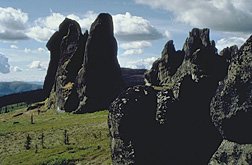 People visiting the Tors in the early spring may find pasque flowers, or crocus, growing in the warm areas. In June and July, visitors will see the face of Munson Ridge covered with a variety of wildflowers - poppies, anemones, and the yellow blossoms of the thorough wax plant. Look for the arctic harebells towards late summer.
People visiting the Tors in the early spring may find pasque flowers, or crocus, growing in the warm areas. In June and July, visitors will see the face of Munson Ridge covered with a variety of wildflowers - poppies, anemones, and the yellow blossoms of the thorough wax plant. Look for the arctic harebells towards late summer.
Weather conditions on the tors can change quickly. Follow these guidelines to make your day at the tors safe and enjoyable: Wear suitable footwear and carry warm clothes and rain gear. Bring insect repellent or netting to ward off persistent pests. Because water sources are not reliable in dry weather, you should bring at least one day's supply of water. Be cautious and alert for the presence in your area of bears. Finally, always let someone know where you are going and when you plan to return.
Trail Safety
When hiking in the park, the Alaska State Parks rangers emphasize:
● Water sources may not be safe to drink and are not reliable in dry weather. Carry plenty of water and purify water collected along the way.
● Portions of the trails are steep and rocky; wear suitable foot gear.
● Carry insect repellent to ward off mosquitoes and gnats.
● Do not attempt rock climbs without proper training and equipment.
● The weather is unpredictable; carry warm clothing and rain gear.
● Always let someone know where you are going and when you plan to return.
Week long expeditions or two-hour day hikes
Angel Creek Hillside Trail
Length: 10 miles to upper cabin
Hiking Time: 5-8 hours
High Point: 1,500 feet
Angel Creek Hillside & Winter Trails Handout
Angel Rocks Trail
Length: 3.5 miles round trip
Hiking Time: 2 to 3 hours
High Point: 1,750 feet
Angel Rock Trail Handout
Angel Rocks to Chena Hot Springs Trail
Length: 8.3 miles round trip
Hiking Time: 5 to 8 hours
High Point: 2,800 feet
Angel Rocks to Chena Hot Springs Trail Handout
Chena Dome Trail
Length: 30 miles round trip
Hiking Time: Three days
High Point: 4,421 feet
Chena Dome Trail Handout
Compeau Trail
Length: 18 miles to cabin
Hiking Time: 10 hours
High Point: 2,150 feet
Compeau Trail Handout
Granite Tors Trail
Length: 15 miles round trip
Hiking Time: 6 to 10 hours
High Point: 3,300 feet
Granite Tors Trail Handout
Mike Kelly Trail
Length: 25 miles round trip
Hiking Time: 3 Days
High Point: 2,600 feet
Mike Kelly Trail Handout
Stiles Creek Trail
Length: 15 miles
Hiking Time: 6 to 10 hours
High Point: 1,900 feet
Stiles Creek Trail Handout
Wildlife
Wildlife is everywhere - animals add the wild touch. Wildlife in Chena River State Recreation Area ranges from small animals like the squirrel, willow grouse and beaver, to large animals like bear and moose. Perhaps an eagle may be sighted soaring overhead. This is a premier place to find wildlife without roaming too far from Fairbanks.
 Moose are the most popular wildlife to try to spot, and are numerous in this area in the summer after mid-June. They are often found near beaver ponds and sloughs where they feed on shrubs and aquatic plants. Moose are often seen near miles 28, 32.8 and 41.5 of Chena Hot Springs Road. These same pond areas are also great spots to see and hear beaver. Sometimes a beaver will see you and smack the water with its tail. This sound alerts other beavers that there is danger nearby.
Moose are the most popular wildlife to try to spot, and are numerous in this area in the summer after mid-June. They are often found near beaver ponds and sloughs where they feed on shrubs and aquatic plants. Moose are often seen near miles 28, 32.8 and 41.5 of Chena Hot Springs Road. These same pond areas are also great spots to see and hear beaver. Sometimes a beaver will see you and smack the water with its tail. This sound alerts other beavers that there is danger nearby.
Other large mammals that inhabit the area are wolves, grizzly bears and black bears. All are wary of people and tend to stay in the back country. Some black bears can be spotted along the river trying to pick up dead or dying salmon during the July and August spawning season. Wolves are more likely to be seen in winter, while you are enroute to a backcountry cabin, but are sometimes spotted darting across the road.
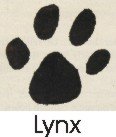 Smaller carnivores in the Chena River Recreation Area include lynx, red foxes (which include the red-, cross-, and silver-colored varieties) and coyotes. Otter, marten and mink are common, but not easily seen. Snowshoe hares, red squirrels, porcupines, voles, woodchucks and muskrats all call the recreation area home, but populations are cyclic. Predators such as lynx and owls are quite common when there are high populations of hares and voles.
Smaller carnivores in the Chena River Recreation Area include lynx, red foxes (which include the red-, cross-, and silver-colored varieties) and coyotes. Otter, marten and mink are common, but not easily seen. Snowshoe hares, red squirrels, porcupines, voles, woodchucks and muskrats all call the recreation area home, but populations are cyclic. Predators such as lynx and owls are quite common when there are high populations of hares and voles.
As for the feathered population, there are several species which are common nesters in the area. Several kinds of warblers, chickadees, sparrows, and thrushes (including the familiar red-breasted robin) raise babies here on the abundant insect populations. Ravens are commonly seen cruising above the road looking for "animal patties."
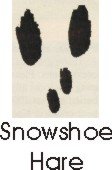 Several species of diving and dabbling ducks also nest or feed in the area. You might see wooden boxes with an oval hole high up in trees. These were installed by student volunteers from the University of Alaska Fairbanks to provide additional nesting habitat for goldeneye ducks. The boxes are designed to imitate a hollow cavity in a tree, and are also used by other cavity-nesting birds and animals such as sparrow hawks, bufflehead ducks, flickers, red squirrels, and hornets. Raptors can also be seen patrolling the skies or sitting in a tree. There are several kinds of owls, eagles, hawks, falcons and harriers in the area.
Several species of diving and dabbling ducks also nest or feed in the area. You might see wooden boxes with an oval hole high up in trees. These were installed by student volunteers from the University of Alaska Fairbanks to provide additional nesting habitat for goldeneye ducks. The boxes are designed to imitate a hollow cavity in a tree, and are also used by other cavity-nesting birds and animals such as sparrow hawks, bufflehead ducks, flickers, red squirrels, and hornets. Raptors can also be seen patrolling the skies or sitting in a tree. There are several kinds of owls, eagles, hawks, falcons and harriers in the area.
Although there have been very few incidents of negative human/wildlife encounters involving injuries to people, the park rangers warn visitors to keep their distance, especially from moose and bears. Always remember to be cautious when encountering wildlife and never feed any of the animals or birds. Even the "sweet" red squirrel can become a destructive nuisance when accustomed to humans' food. Because there are so many moose in the area, always be alert when driving - one could jump out onto the road at any time.
Winter Activities
Most trails in Chena River State Recreation Area offer opportunities for snowshoeing and cross country skiing, two winter activities allowed throughout the park. Generally, the trails are packed for these activities either by snowmachine riders or by snowshoeing and skiing enthusiasts traveling along the trail.
Twin Bears Camp offers an exception to this norm. There you can find two cross country ski trails that are occasionally groomed. One is 5 km., about 3 miles long and the other is 3.5 km., about 2 miles long. These intermediate level trails are set with single tracks, about 32 inches wide, after major snowfalls. The tracks are maintained by the Alaska Division of Parks and Outdoor Recreation, by private contractors, and by volunteer organizations. The 5-kilometer loop takes approximately one hour to two hours to complete. The shorter loop will require about one hour, possibly less for experienced skiers. The loops connect with the Chena Hot Springs Winter Trail, presenting skiers with an exciting variety of possible routes.
When skiing the loops, be sure to ski in a clockwise direction as indicated on the accompanying map. Hills, sharp turns, and the narrow width of the trail could make two-way skiing dangerous. The ski trailhead is at mile 30 of Chena Hot Springs Road.
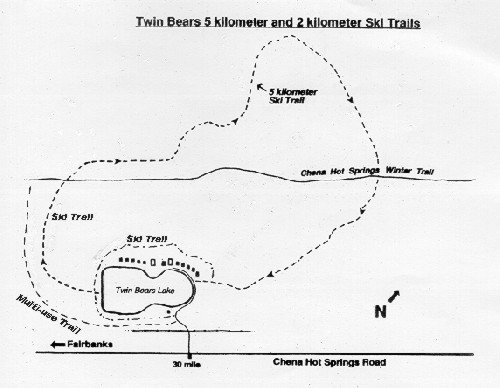
Winter Mountain Biking -- a New Twist on a Summer Sport
Mountain bikers are discovering that Chena River Recreation Area trails offer more than fair-weather riding. Increasing numbers of bicyclists are venturing onto area trails for winter riding. Snow-covered winter trails are often well-packed thanks to long periods between snowfalls in Alaska's Interior, and riders are discovering scenery and solitude go hand-in-hand on winter rides. Local mountain biking enthusiasts recommend several trails in the recreation area for winter biking. The Colorado Creek Trail is a good choice for a short winter day ride, typically taking 3 to 4 hours. From the parking area at 31.5 mile Chena Hot Springs Road, the distance is 5.8 miles to the Colorado Creek Cabin, making for a round trip of 11.6 miles with an approximate 600 ft. elevation gain. The main trail is well marked.
Another popular trail is the Angel Creek Valley Trail, which begins at mile 50.5 Chena Hot Springs Road. This trail will travel to two separate State Parks cabins. The first cabin is at mile 3.6 and the second is at mile 6.8. Round-trip distance is 13.6 miles with an elevation gain of about 600 feet. The trail gets less midwinter sun than other area trails, but is usually well-packed by snowmachines.

The Chena Hot Springs Winter Trail is generally well-packed and level, and is a good choice for persons new to winter mountain biking. This trail does receive heavy use from dog teams. Riders can access the trail at mile 26.6 and ride all the way to the hot springs, for a one-way distance of over 30 miles.
According to local experts, winter mountain biking only requires a few extra preparations beyond that of normal riding. One tip for winter riding is gluing tires to the rims, using tire glue available at local bike shops. This allows for running the tires at low pressure without damage to tires or valve stems. Some riders invest in special rims for winter riding. The most important consideration for winter riding is appropriate clothing and survival gear. Winter temperatures can dip to minus 30 degrees F, and can range above plus 30. The same layered clothing recommended for winter hiking and cross-country skiing works well for winter biking. Riders must take care to carry extra food and to drink plenty of fluids.
Winter activities abound in the recreation area
If the temperature is nippy and there's enough snow on the ground, you might catch Ev Wenrick with his dog Jack out on the ski trails at Chena River State Recreation Area. Wenrick first tried cross-country skiing 23 years ago, and he has covered thousands of miles since then. "I got hooked," Wenrick said.
Like many winter sport enthusiasts, Wenrick appreciates the Chena River State Recreation Area because of its scenery and challenging trails. The trails in the area offer many opportunities for winter adventure from mid-October to mid-April. The cabins are spaced so that skiers can reach them in an easy day ski, and continue on from there, deeper into the park. Skiers can choose between relatively flat trails like the one that leads to Colorado Creek cabin, or steeper and tougher trails such as the Stiles Creek Trail that leads to the Stiles Creek Cabin.
A group that is a cross between the mushers and skiers is the skijoring group, or skiers who are attached to one, two, or even three dogs. Use of the cabins and trail system by this group is strong. Beginning skijorers frequent the closer cabins, and often ski the more difficult terrain after leaving their dog-hauled gear at the cabin. More adventurous skijorers tackle the toughest terrain the park has to offer, enjoying the bond that the challenge brings between them and their dogs.
Many of the park's visitors come from as far away as Anchorage to snowmachine. The vehicles are a popular way to reach the Public-Use Cabins, which are available for rent all year long. People snowmachine out, stay the night, and snowmachine back.
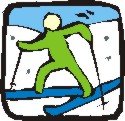 Four cabins are located on trails three to seven miles from Chena Hot Springs Road. Another cabin one-quarter mile from the road can be reached by car. Easy access to the cabins is not the only reason snowmachiners flock to the recreation area. Many people like the long range travel made possible by snowmachines, and the amount of gear that they can carry for extended trips. "People all over the world know we've got world-class snowmachining up here," said Bob Krize, owner of Alaska River Charters and a member of the Fairbanks Convention and Visitors Center Bureau Board. "We're trying to get more people from the Lower 48 to come up and ride." Trails for snowmachines are designated as such. Park officials ask that riders make certain they are using the appropriate trails.
Four cabins are located on trails three to seven miles from Chena Hot Springs Road. Another cabin one-quarter mile from the road can be reached by car. Easy access to the cabins is not the only reason snowmachiners flock to the recreation area. Many people like the long range travel made possible by snowmachines, and the amount of gear that they can carry for extended trips. "People all over the world know we've got world-class snowmachining up here," said Bob Krize, owner of Alaska River Charters and a member of the Fairbanks Convention and Visitors Center Bureau Board. "We're trying to get more people from the Lower 48 to come up and ride." Trails for snowmachines are designated as such. Park officials ask that riders make certain they are using the appropriate trails.
Local mushers take advantage of the area's terrain to train for the 1000-mile Yukon Quest, the Iditarod and local dog sled races. The Chena Hot Springs Winter Trail, used by the Yukon Quest sled dog race, runs through the recreation area for about 26 miles. Mushers also enjoy the use of the cabins. "A lot of people train their dogs there," Hunt said, adding that some smaller local dog sled races are held within the recreation area itself.
Trappers and hunters find that small game animals are abundant in the park during the winter months. Sport hunting includes moose, bear, rabbit, grouse, ptarmigan and fur animals. Park officials advise that people bringing firearms into the recreation area familiarize themselves with appropriate regulations.
Wildlife viewing and photography offer additional incentives to seek out animals in the recreation area. Grouse, fox and lynx are common in the park and moose are everywhere. Snowshoeing is a great way to follow animal tracks. New trail development proposals at the Chena River State Recreation Area promise to provide even more areas for winter sport enthusiasts to enjoy. Some of the well-established trails may be linked together. Some day in the future it will be possible to reach the 300 miles of winter trails and ten cabins in the White Mountains National Recreation Area. "It's better every year, and I think it will keep getting better," Krize said. Don't miss out on the many opportunities available.


